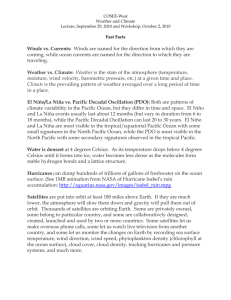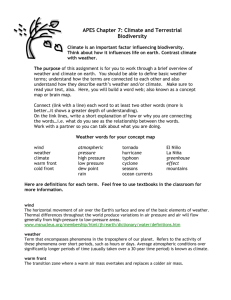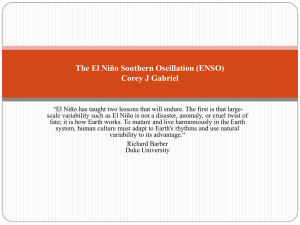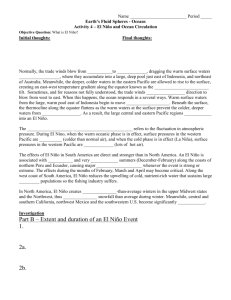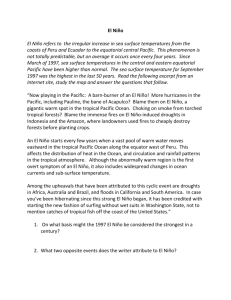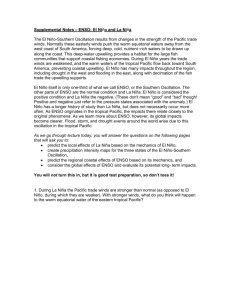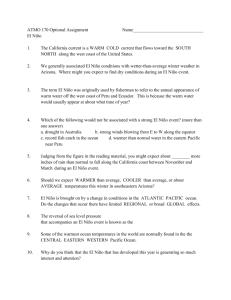GEOS170C WORKSHOP 8 -- ENSO
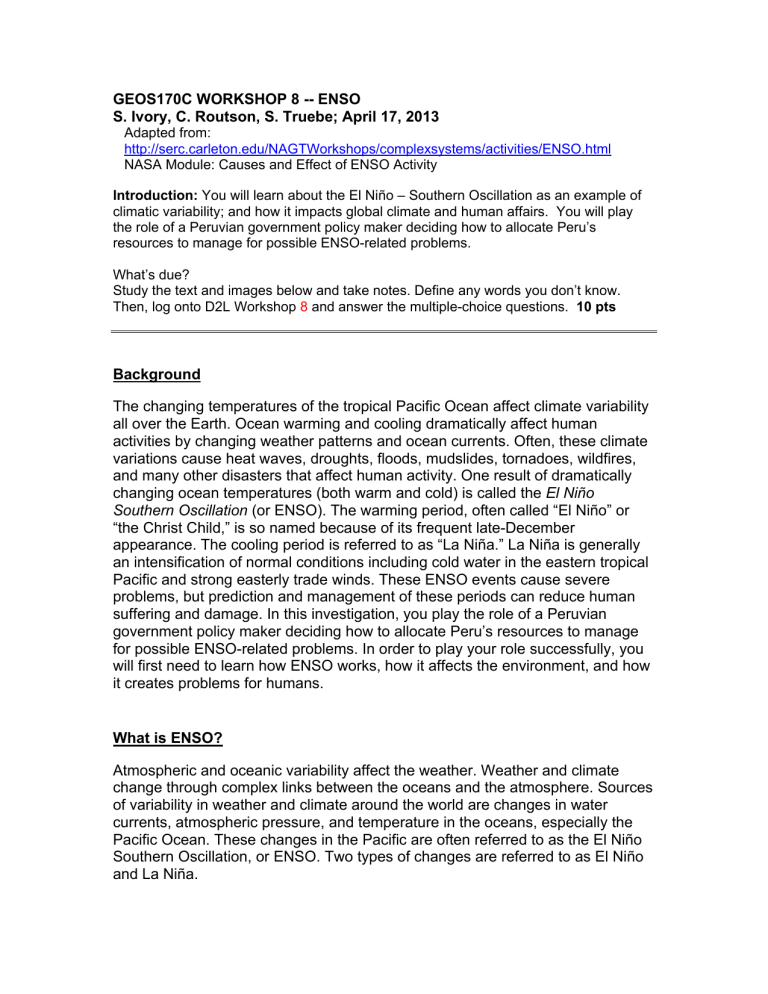
GEOS170C WORKSHOP 8 -- ENSO
S. Ivory, C. Routson, S. Truebe; April 17, 2013
Adapted from: http://serc.carleton.edu/NAGTWorkshops/complexsystems/activities/ENSO.html
NASA Module: Causes and Effect of ENSO Activity
Introduction: You will learn about the El Niño – Southern Oscillation as an example of climatic variability; and how it impacts global climate and human affairs. You will play the role of a Peruvian government policy maker deciding how to allocate Peru’s resources to manage for possible ENSO-related problems.
What’s due?
Study the text and images below and take notes. Define any words you don’t know.
Then, log onto D2L Workshop 8 and answer the multiple-choice questions. 10 pts
Background
The changing temperatures of the tropical Pacific Ocean affect climate variability all over the Earth. Ocean warming and cooling dramatically affect human activities by changing weather patterns and ocean currents. Often, these climate variations cause heat waves, droughts, floods, mudslides, tornadoes, wildfires, and many other disasters that affect human activity. One result of dramatically changing ocean temperatures (both warm and cold) is called the El Niño
Southern Oscillation (or ENSO). The warming period, often called “El Niño” or
“the Christ Child,” is so named because of its frequent late-December appearance. The cooling period is referred to as “La Niña.” La Niña is generally an intensification of normal conditions including cold water in the eastern tropical
Pacific and strong easterly trade winds. These ENSO events cause severe problems, but prediction and management of these periods can reduce human suffering and damage. In this investigation, you play the role of a Peruvian government policy maker deciding how to allocate Peru’s resources to manage for possible ENSO-related problems. In order to play your role successfully, you will first need to learn how ENSO works, how it affects the environment, and how it creates problems for humans.
What is ENSO?
Atmospheric and oceanic variability affect the weather. Weather and climate change through complex links between the oceans and the atmosphere. Sources of variability in weather and climate around the world are changes in water currents, atmospheric pressure, and temperature in the oceans, especially the
Pacific Ocean. These changes in the Pacific are often referred to as the El Niño
Southern Oscillation, or ENSO. Two types of changes are referred to as El Niño and La Niña.
El Niño is the name given to the occasional warming of surface waters in the central and eastern equatorial Pacific Ocean. Under normal conditions, easterly trade winds blow from east to west along the equator and push warm surface water to the western tropical Pacific, where it piles up near Indonesia and the
Australian continent (Figures 1, 2, 3). The persistent easterly trade winds are key ingredients of ENSO, because they push warm water toward the western Pacific.
This gives that area the warmest ocean temperatures on Earth and is often called the warm pool. Usually above 28 degrees C (82 degrees F), parts of this pool are sometimes as warm as 31.5 degrees C (89 degrees F). Because this large pool of warm water is pushed towards the western Pacific, the atmosphere above the ocean is heated, causing favorable conditions for convection and precipitation. In fact, the persistent oceanic heat surrounding Indonesia and other western Pacific islands leads to frequent thunderstorms and some of the heaviest rainfall on Earth.
In the upper levels of the atmosphere, the winds blow from west to east, completing a large-scale atmospheric circulation known as the Walker
Circulation, named after Sir Gilbert Walker who studied variations in the tropical
Pacific atmosphere during the 1920s.
As stated earlier, the easterly trade winds push warm surface water against the western boundary of the Pacific Ocean. On the eastern boundary, colder, more nutrient-rich water comes up from below along the coast of South America to replace it. This is called upwelling. Upwelling provides nutrients from the deep ocean that helps fish and other animals thrive.
In addition, as the warm surface water moves westward, the layer dividing the warm surface water and deep cold water, known as the thermocline, is raised.
Because warm water contains more volume than colder water, and because trade winds push the water westward, the sea level is higher on the western side of the Pacific. In fact, the sea level in the Philippines is normally about 60 centimeters (23 inches) higher than the sea level on the southern coast of
Panama.
In an El Niño year (Figures 1, 3), which typically occurs every three to seven years, the normal trade winds diminish and the warm pool of water in the western
Pacific is free to move back along the equator toward the east and the South
American continent. The sea level drops in the west and rises in the east as warm surface water surges along the equator in the form of a pulse, or a Kelvin
Wave. In addition, the upwelling of cold water along the South American coast decreases, reducing the supply of nutrients to fish and other animals. This can negatively impact people who depend on coastal fisheries for their livelihoods.
This displacement of the warm water affects the atmosphere. The convection and precipitation that previously occurred in the western Pacific follows the warm pool to the central and eastern Pacific and usually results in heavier than normal rains over areas such as northern Peru, Ecuador, and other areas in tropical
South America. In the western Pacific, the mechanism for precipitation is shut off, and Indonesia and Australia will often experience drought conditions while an El
Niño persists.
In a La Niña year (Figures 2, 3), unusually cold ocean temperatures occur in the equatorial Pacific, which is the opposite of an El Niño. Generally, during a La
Niña, the easterly trade winds increase in intensity, more upwelling occurs off
South America, and the water temperatures along the equator are reduced. This usually results in less cloudiness and rainfall for South America and more rainfall over Indonesia, Malaysia, and northern Australia.
Figure 1: El Niño circulation pattern on the equator in the Pacific Ocean
Figure 2: Normal and La Niña circulation patterns on the equator in the Pacific Ocean.
Image source: http://sageography.myschoolstuff.co.za
Figure 3. Upper panel shows sea surface temperature patterns during El Niño, lower
La Niña from the Ausie Met Bureau http://www.bom.gov.au/climate/enso/feature/ENSOfeature.shtml
